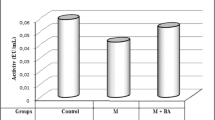Abstract
Uptake of dehydroascorbic acid (DHA) was studied in two types of dog erythrocytes with high GSH and normal GSH levels. Compared with ascorbic acid uptake, DHA produced a much greater ascorbic acid accumulation in dog erythrocytes. Both dog erythrocytes showed a concentration dependence of DHA uptake, and cellular ascorbic acid concentrations were significantly higher in high-GSH cells than in normal-GSH cells. Glucose and cytochalasin B inhibited DHA uptake. This suggests that DHA enters dog erythrocytes predominantly by the facilitated glucose transporter, particularly by the Glut 1 glucose transporter. The rate of glucose uptake was quite similar in the two types of cells. Compared with normal-GSH cells, high-GSH cells were more resistant to oxidative stress induced by high concentration of DHA. As a rapid entry of DHA inflicts on cells a heavy demand for GSH for its reduction to ascorbic acid, high-GSH cells containing a larger reserve of GSH have an advantage over normal-GSH cells in both ascorbic acid accumulation and resisting oxidative stress produced by DHA.




Similar content being viewed by others
References
Beutler E, Duron O, Kelly BM (1963) Improved method for determination of blood glutathione. J Lab Clin Med 61:882–888
Bianchi J, Rose RC (1986a) Glucose-independent transport of dehydroascorbic acid in human erythrocytes. Proc Soc Exp Biol Med 181:333–337
Bianchi J, Rose RC (1986b) Dehydroascorbic acid and cell membranes: possible disruptive effects. Toxicology 40:75–82
Board PG, Agar NS (eds) (1983) Glutathione metabolism in erythrocytes. In: Red blood cells of domestic mammals. Elsevier, Amsterdam, pp 253–270
Davis JL, Mendiratta S, May JM (1998) Similarities in the metabolism of alloxan and dehydroascorbate in human erythrocytes. Biochem Pharmacol 55:1301–1307
Fiorani M, Saltarelli R, De Sanctis R, Palma F (1996) Role of dehydroascorbate in rabbit erythrocyte hexokinase inactivation induced by ascorbic acid /Fe(II). Arch Biochem Biophys 334:357–361
Fiorani M, Saltarelli R, De Sanctis R, Stocchi V (1997) Hexokinase inactivation induced by ascorbic acid/Fe(II) in rabbit erythrocytes is independent of glutathione-reductive processes and appears to be mediated by dehydroascorbic acid. Arch Biochem Biophys 342:191–196
Heard KS, Fidyk N, Carruthers A (2000) ATP-dependent substrate occlusion by the human erythrocyte sugar transporter. Biochemistry 39:3005–3014
Hegesh E, Gruener N, Cohen S, Bochkovsky R, et al (1970) A sensitive micromethod for the determination of methemoglobin in blood. Clin Chim Acta 30:679–682
Himmelreich U, Drew KN, Serianni AS, Kuchel PW (1998) 13C NMR study of vitamin C transport and its redox cycling in human erythrocytes. Biochemistry 37:7578–7588
Hughes RE, Maton SC (1968) The passage of vitamin C across the erythrocyte membrane. Br J Haematol 14:247–253
Kahn MM, Martell AE (1967) Metal ion and metal chelate catalyzed oxidation of ascorbic acid by molecular oxygen. I Cupric and ferric ion catalyzed oxidation. J Am Chem Soc 89: 4176–4185
May JM, Qu ZC, Whitesell RR (1995) Ascorbic acid recycling enhances the antioxidant reserve of human erythrocytes. Biochemistry 34:12721–12728
May JM, Qu ZC, Whitesell RR, Cobb CE (1996) Ascorbate recycling in human erythrocytes: role of GSH in reducing dehydroascorbate. Free Radic Biol Med 20:543–551
Mendiratta S, Qu ZC, May JM (1998a) Erythrocyte defenses against hydrogen peroxide: the role of ascorbic acid. Biochim Biophys Acta 1380:389–395
Mendiratta S, Qu ZC, May JM (1998b) Erythrocyte ascorbate recycling: antioxidant effects in blood. Free Radic Biol Med 24:789–797
Ogawa E, Shibuya A, Toda M, Miwa H, et al (2003) Effects of ascorbic acid on high GSH and normal dog erythrocytes (I). Comp Clin Pathol 12:155–159
Ogawa E, Sugimoto Y, Agar NS (2004) Effects of ascorbic acid on high-GSH and normal-GSH dog erythrocytes (II). Comp Clin Pathol 13:19–23
Patterson JW (1951) Course of diabetes and development of cataracts after injecting dehydroascorbic acid and related substances. Am J Physiol 165:61–65
Patterson JW, Lazarow A (1950) Sulfhydryl protection against dehydroascorbic acid diabetes. J Biol Chem 186:141–144
Sherry S, Ralli EP (1948) Further studies of the effects of insulin on the metabolism of vitamin C. J Clin Invest 27:217–225
Vera JC, Rivas CI, Fischbarg J, Golde DW (1993) Mammalian facilitative hexose transporters mediate the transport of dehydroascorbic acid. Nature 364:79–82
Vera JC, Rivas CI, Zhang RH, Farber CM, Golde DW (1994) Human HL-60 myeloid leukemia cells transport dehydroascorbic acid via the glucose transporters and accumulate reduced ascorbic acid. Blood 84:1628–1634
Vera JC, Rivas CI, Velasquez FV, Zhang RH, Concha II, Golde DW (1995) Resolution of the facilitated transport of dehydroascorbic acid from its intracellular accumulation as ascorbic acid. J Biol Chem 270:23706–23712
Wagner ES, White W, Jennings M, Bennett K (1987) The entrapment of [14C]ascorbic acid in human erythrocytes. Biochim Biophys Acta 902:133–136
Author information
Authors and Affiliations
Corresponding author
Rights and permissions
About this article
Cite this article
Ogawa, E., Otsubo, Y., Taira, N. et al. Uptake of dehydroascorbic acid in high-GSH and normal-GSH dog erythrocytes. Comp Clin Path 13, 137–141 (2005). https://doi.org/10.1007/s00580-004-0529-z
Received:
Accepted:
Published:
Issue Date:
DOI: https://doi.org/10.1007/s00580-004-0529-z




